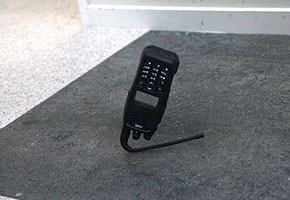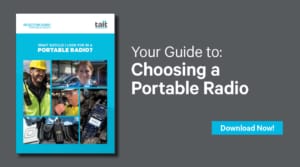Different jobs and environments require different levels of portable radio ruggedness. Users that work in an office don’t need a rugged or military grade radio, but police, fire, emergency services, utility workers, miners, and oil riggers face challenging conditions every day, making communications equipment that can take a beating a necessity.
This blog is part of a series focusing on what factors you should consider when selecting a portable radio – you can find the other posts here.
Because there’s such a wide range of users, roles and environments, what is required of a radio varies wildly – there is no such thing as a one-size-fits-all radio. When it comes to the build quality of a portable radio is, the most important question you should be asking yourself is: “Can it survive my workplace?”
In this blog post, we’ll highlight some important build quality factors you should consider when choosing a portable radio.
Ruggedness: Drop and Immersion Tests

Portable radios undergo tests to ensure ruggedness
When you work in demanding environments, you’ll need a portable radio that’s reliable, resilient, and downright tough. To make sure they can endure some rough treatment, portable radios undergo drop and immersion tests.
For the highest level of protection, look for IP ratings that suit your work situation, shock absorbing features to protect the radio from impact, and when you work outdoors or on the water, make sure the radio’s design is water-shedding.
IP Ratings
IP (Ingress Protection) ratings are a defined international standard indicating the level of protection an electrical device has against dust and water getting inside. The IP rating is a two-digit grading system, and the numbers following ‘IP’ have specific meanings.
The first number indicates the degree of protection against moving parts and dust getting in, and the second number defines how protected the device is from moisture. Common examples for portable radios include:
- IP54: dust and water resistant
- IP65: dustproof and protected against water jets for at least three minutes
- IP67: dustproof and can be immersed in water at a depth of one meter for thirty minutes
- IP68: dustproof and can be immersed in water at a depth of two meters for thirty minutes or a depth of one meter for two hours

Is your radio’s IP-rating suited to your work environment?
Military Standards
Some radios are advertised as ‘tested to meet Military Standards’. These tests were originally designed for military devices, but are now commonly used for commercial products, and are promoted as MIL-STD or MIL-SPEC.
There are a lot of tests that can be used to achieve Military Standards, such as low and high pressure, rain, humidity, salt fog, dust, vibrations and shocks. However, not all MIL-SPEC equipment has been subjected to all test methods – so make sure you check whether a MIL-SPEC radio has passed the tests important to your work environment.
Tait Portables Build Quality
Tait portable radios are renowned for their toughness, and they’ve been tested and proven to survive even in the harshest environments.
We carefully select and test every component to ensure our radios can endure harder knocks and more extreme temperatures. The radios are then assembled and tested in our own factory, so we can deliver maximum quality. Every Tait portable is proven to meet Military Standards 810C, D, E, F, and G.
And it doesn’t end there! To earn the Tait Tough accolade, our TP9000 radios have been crushed by tanks, dropped by drones, tossed in the ocean, and even run through a dishwasher – and they still work afterwards. To watch Tait radios survive some punishment, visit www.taitradio.com/taittough
Download our Free Guide to Learn More
If you want more information on build quality and other important factors to consider when choosing a portable radio, download our free Portable Radio Selection Guide.





